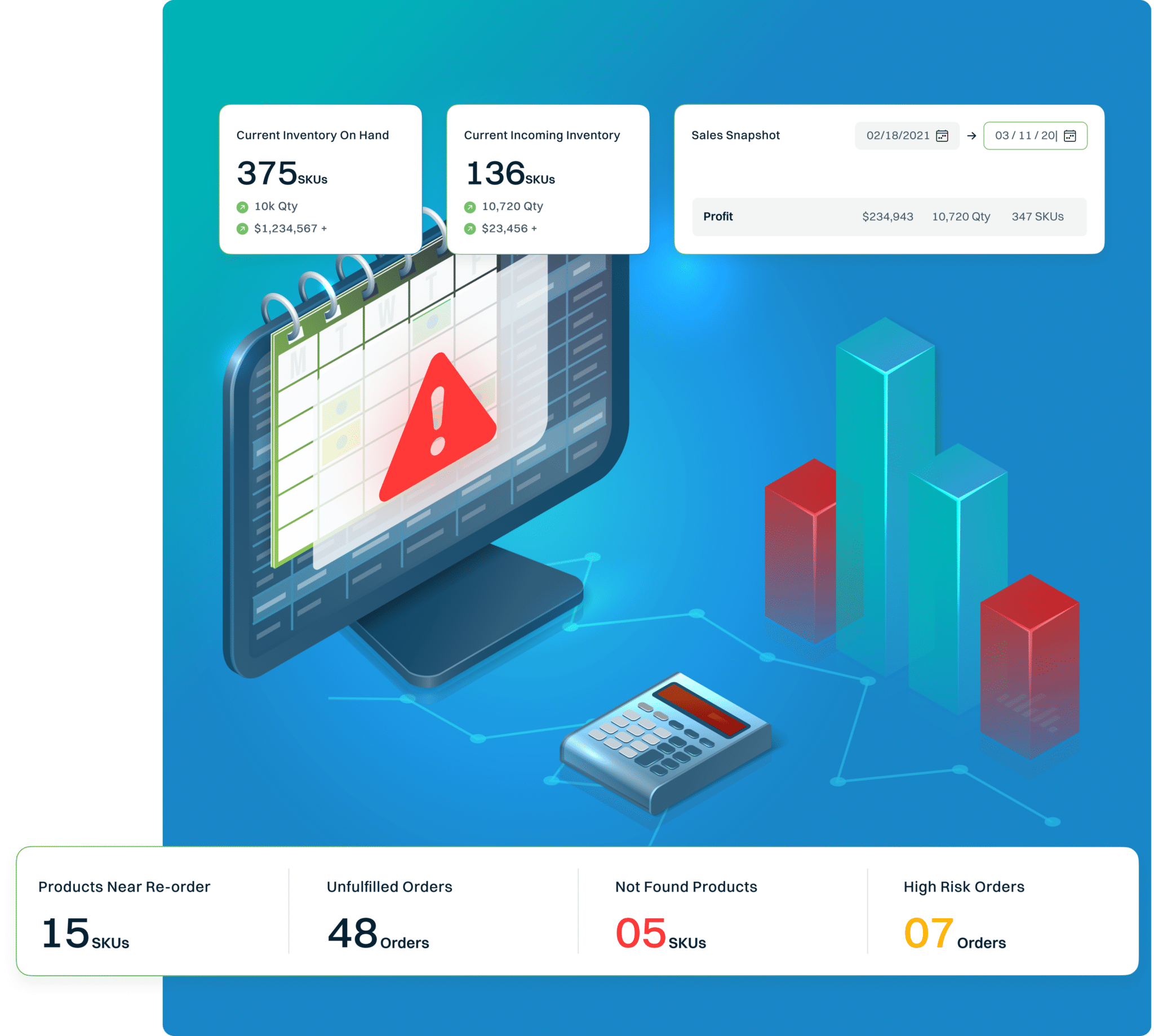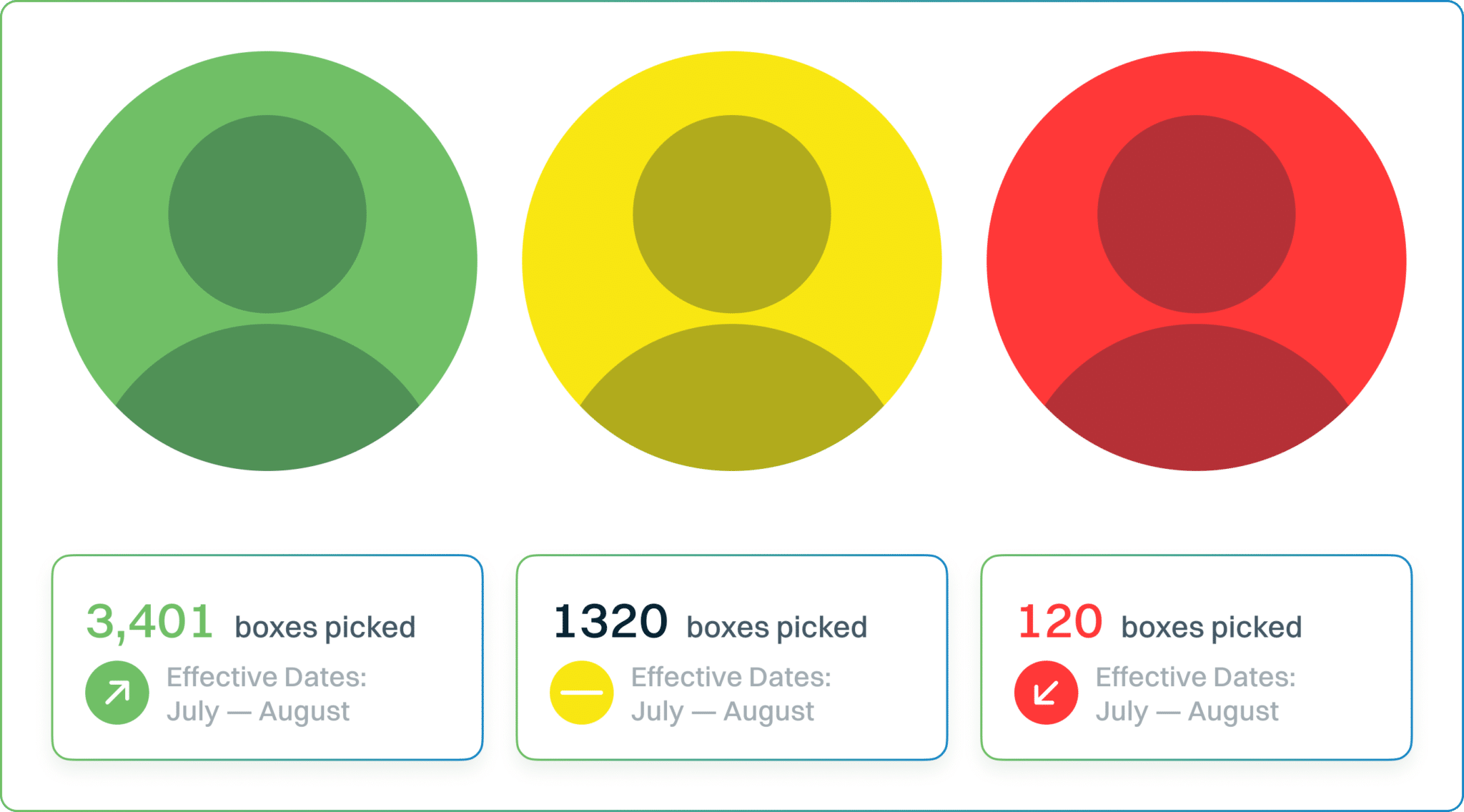3PL Warehouse Management Software: What to Look For and How to Choose

As a 3PL provider, your primary customer is your client. And their primary customer is the end-user.
The shift from in-house 2PL fulfillment to 3PL is a scary one for most eCommerce businesses. They’re trusting another entity to handle their process, their product, and their customers with care.
As the name implies, 3PL clients are at least three steps removed from the end-user. Each step requires that much more trust in the firm they hire to fulfill orders.
With a traditional 2PL strategy, the shipping provider is the only separate entity the business owner needs to trust. With 3PL, clients trust you to store, assemble, pick, pack, and ship products efficiently.
The key to customer retention and satisfaction — both at the client and end-user level — is developing a solid 3PL inventory management strategy. Warehouse management software is a necessary component of that strategy.
What is Inventory Management for 3PL?
When you think of the word “logistics,” what comes to mind? Perhaps boxes, shelves of products, forklifts, or barcodes.
In truth, logistics simply refers to the art and science of getting something from point A to point B.
While it’s simple to define, it’s certainly not simple in practice. There are many sub-disciplines and complexities within logistics and inventory management.
Good 3PL inventory management looks at every stage of the 3PL product lifecycle. This includes:
- How product is received and ingested from the clients
- How you store product in the warehouse
- The picking, packing, and processing workflow
Just to name a few. Inventory management is not only about documenting all the steps necessary for smooth operation but constantly optimizing them.
That may mean making employee picking patterns more efficient or automating data entry to avoid mis-ships. It may mean broadening freight options to provide the cheapest and most efficient solution to the customer. We could go on and on.
That’s the discipline of 3PL inventory management — putting every step of the logistics process under a microscope and asking, “How can I make this even better?”The best way to accomplish this and facilitate profitability, efficiency, and client trust is with dedicated warehouse management software (WMS).
What are the Benefits of Warehouse Software for 3PL?
Let’s be honest with ourselves for a second here. We’re in 2021. When evaluating 3PL providers, most clients likely won’t give you a second thought if you don’t use some sort of warehouse management software.
Clients are savvier and more well-researched than ever. They know enough about the 3PL world to know that manually juggling multiple clients and their logistical complexities is insanity.
In addition to keeping up with the status quo of client expectations, there are at least six distinct benefits of using 3PL warehouse software.
In this section, we’ll survey those benefits. In subsequent sections, we’ll look at the specific feature sets that make them possible.
Automation
Most of the necessary tasks in warehouse management are ones that robots could easily do. That’s the plain and simple truth.
However, this shouldn’t discourage 3PL owners or employees. Getting out of the monotony of inventory management frees you up to add value where only you can add value.
For example, how much time could you save if you could automatically aggregate and generate reports on how many items were picked in a given month in your 3PL facility?
What if you didn’t have to do any manual data entry, but all client SKUs and barcodes were created and collected in one repository?
How much time would your employees save if you had a dynamic pick-route that showed the most efficient way to pick a given order?
What about automating reorder points or syncing with your CRM, channel management, and invoicing platforms?
These are just a few of the things warehouse management software offers to 3PL providers. It streamlines each step involved in running a 3PL business.
Visibility
It’s of paramount importance to have visibility not only internally but with your clients. They want to know that they’re getting their money’s worth (and so do you). Warehouse management software gives you on-hand and in-transit inventory data in real-time.
You can generate reports on a client-by-client level or even drill down into specific marketplaces and their performance. For example, if a client requests info on the number of returns you’ve processed from Amazon, you can generate and send that data over with a few clicks.
The key to repeat business and client trust is transparency. Warehouse management software offers this to 3PL providers.
Efficiency
We’ve said this several times on our blog, but it bears repeating. We measure warehouse time in seconds, not minutes. Every second wasted not only costs you money but can compound into shipping delays.
Delays lead to an erosion of trust between you and the client (especially if their customers don’t have a good experience).
Warehouse management software simplifies and streamlines the entire fulfillment process by offering key time-saving features. Things like wave picking, mobile-optimized pick lists, and automatic label printing help warehouse employees focus on picking the right product quickly.
Scalability
Manual inventory management systems built in spreadsheets or — heaven forbid — with paper and pen will quickly reveal their limitations. This is especially true if your 3PL business is interested in growing.
Scaling up operations will look a bit different for each 3PL provider. For some, it will mean taking on new clients with unique needs. For others, it will mean scaling up their existing clients’ SKU count or expanding their warehouse infrastructure.
A solid WMS like SkuVault will grow with your business regardless of how you define “growth.” Manual processes simply can’t sustain 3PLs that want to scale.
Customizability
As you serve more and more clients, you’ll begin to notice all their distinctive needs and preferences. Some clients will ship by the pallet. Others will require a FIFO or LIFO fulfillment workflow. Some may even require kitting or assembly.
Any single fulfillment strategy likely won’t work for all your clients. That’s why your WMS must be as dynamic as your customer base.
A robust WMS will support unique SKUs and barcodes, and custom reporting options for each client.
Profitability
Every previous benefit is in service of this last one — the almighty dollar. Profitability is the sum total of all these other efforts.
Profitability often doesn’t come from one single thing but many things. It’s optimizing every process, workflow, and behavior in your business.
It’s putting everything under a microscope, as we described before, and making sure each step in the logistics lifecycle is the best it can be.
A robust warehouse management platform is the best way to achieve this. Now that we’ve reviewed why every 3PL needs warehouse management software, let’s go deeper into the features that support these benefits.
What are the Critical Features of 3PL Warehouse Management Software?
Hopefully, the benefits listed above have at least piqued your interest in investing in a WMS. But what should you look for in the evaluation process? What are the specific features that help your organization realize these benefits and increase profitability?
Let’s take a systematic look at some critical warehouse management software features for 3PL providers:
Flexible Scanning Capabilities
No tool or system has served the warehouse management industry so well as the humble barcode.
The cost-to-value ratio of implementing a barcoding system is a no-brainer. It increases fulfillment speed exponentially and reduces almost all manual data entry. The bottom line is that barcoding goes a long way in mitigating human error in your warehouse.
It is technically possible to rig together a barcode system with free tools. You even might be able to get away with that for a single, low-volume eCommerce shop.
However, when you’re dealing with multiple SKUs from many clients, each of which needs to be distinct, that simply won’t fly.
Further, when you start integrating important information into your barcodes like lot or group numbers (essential for a FIFO or LIFO strategy), things can get very messy.
With a WMS, each barcode scan — regardless of client or SKU — is logged safely in a single repository. You don’t need to reconcile multiple databases or systems. It’s all in one spot.
Quick, customizable Reporting
Many 3PL companies bill their clients on a per-order or per-pick basis (in addition to baseline storage costs). This pricing structure necessitates quick access to picking data on a client-by-client basis.
ShipTo, a 3PL organization using SkuVault, uses the Transaction Report to quickly determine the number of picks tied to a given client. Compiling invoices used to require lots of manual number crunching for ShipTo stakeholders. Now, it’s done in a matter of minutes.Quality Control Features
eCommerce entrepreneurs are (understandably) fanatical about quality control. They not only want their customers to receive the products on time, but they want every aspect of the experience — including the packaging and unboxing — to be special.
This means your 3PL is always one mis-ship or poor customer experience away from losing clients.
Many WMS platforms will include a final quality control checkpoint built into the software workflow. This keeps everyone happy and also helps identify patterns in problematic suppliers or employees.
Safety Stock Reminders
It’s hard enough to keep track of when to reorder products when you’re just running your own eCommerce shop. When you’re managing four clients and dozens of SKUs? Forget it. Nobody can hold all that info in their brain (and stay sane, at least).
We’ve written about the importance of maintaining safety stock as a buffer against stock-outs. But constantly checking inventory levels isn’t a wise use of your time. That’s why you should make sure whatever WMS you choose has reorder point alerts.
That way, you can focus on growing your business and trust the system to remind you when it’s time to request more products from the client.
Cloud-based Technology
Unless you’re the CIA or dealing with highly classified data, local (on-site) software solutions are slowly going the way of the dodo.
If the COVID-19 lockdowns have taught us anything, it’s that most of the work in the modern world can be done from within a few browser tabs.
Cloud-based technology is especially important for 3PLs with multiple locations, mobile-based scanning devices, or remote workers.
You won’t find many WMS platforms that offer local installation alone, but it’s still a critical factor to look out for.
Purchase Order Generation
When you consider the best candidates for automation in a warehouse setting, creating purchase orders is at the top of the list.
It’s one of the most essential, yet tedious tasks involved in running a 3PL organization. In your hunt for a WMS, make sure you find one that supports purchase order templating.
Most POs are almost identical month-to-month for each client. While there may be some slight variances, it’s not worth creating a new PO every time.
A WMS like SkuVault will actually create intelligent purchase orders based on client reports, streamlining the process even further.
This is another way you can improve client and vendor relationships — by being punctual, clear, and professional with your purchase orders.
Multi-client Capabilities
This may seem like an obvious one, but some WMS platforms aren’t built for supporting 3PLs or multiple clients. You’ll want to make sure you find some information — a case study or feature overview — that explicitly offers support for multiple clients.
Quantity Buffering
Anyone who’s shopped online has come across a message along the lines of, “Hurry! Only 4 left in stock!”
If that’s ever motivated you to purchase, that’s highly intentional. Sure, sometimes there are genuine low-stock scenarios, but a lot of the time, vendors are using scarcity to drive sales.
It’s always a good idea to have this capability should your clients desire it. Many modern WMS platforms will allow you to implement buffers on either a channel-wide or individual product basis.
These buffers override the actual quantities of on-hand inventory to give the illusion of scarcity. For example, SkuVault offers a variety of buffer options like “Maximum Quantity,” “Push Constant Quantity,” or “Low Quantity Cutoff” to support your clients’ preferences.
Multi-warehouse Visibility
In addition to supporting multiple clients, you’ll want to make sure whatever WMS you choose can support multiple physical locations — and distinguish between them.
Some WMS platforms even allow you to assign zip codes for order routing. This automation allows you to ship from the warehouse closest to the end-user destination.
Make sure whatever software you choose specifies product locations on a per-warehouse basis for streamlined picking and packing.
Multiple Receiving Options
Receiving products is a huge responsibility for 3PLs. It’s important to ensure the product you ordered from the client arrived safely before it’s cataloged and stored. If you mess up this initial “ingestion” process, all your other metrics will be skewed.
Many WMS platforms include multiple receiving options, including receiving from a previously-generated purchase order. That way, reconciling what you ordered with what you actually received is simple and streamlined.
Integrations With Popular Platforms
Just as raising a child “takes a village,” keeping a 3PL afloat requires numerous software products. It’s essential that whatever inventory management software you choose integrates with your entire technology stack.
That includes:
- Point-of-sale systems
- Accounting platforms
- Channel management applications
- CRMs
- Specific channel back-ends (like Amazon, eBay, or Etsy)
The first step is to audit your current software stack and create a plan for how they’ll all integrate with your WMS. Next, ensure that whatever platform you choose has either direct integration or API support for your mission-critical software.
See here for a complete list of SkuVault’s integrations.
Analytics and Forecasting
You can’t fix what you can’t measure. Analytics are of paramount importance if you want your 3PL to experience good growth.
You need a WMS that will give you a 30,000-foot view of everything happening in your warehouse from a single dashboard. Also, you’ll need reports that can drill down on the client, warehouse, or SKU level, all of which can be found in SkuVault’s latest product launch, DataCoach.

These sorts of analytics have the double benefit of revealing bottlenecks in your inventory management strategy while also providing insight into the future based on historical data.
Easy Onboarding and Strong Customer Service
If you’re going all in on a WMS, you’ll want to know you have a solid customer service team covering your six. You’ll also want to find a platform that doesn’t require shutting down operations for two weeks just to get onboarded.
As you’re evaluating platforms, make sure you find one with robust support documentation, an onboarding or training option, and over-the-phone customer support options.
Supplier and Lead Time Tracking
The key to avoiding stock-outs involves a two-pronged strategy. First, you have to determine your safety stock (how much product you need as a buffer), then you need to determine your lead time (how long it takes to receive ordered product).
Many modern WMS platforms will allow you to track multiple supplier costs, lead times, and part numbers for a given product.
For example, SkuVault pulls vendor contact information directly into purchase order templates, eliminating the need to hunt down vendor data.
Kitting and Bundling Options
I mentioned above that some clients will have very distinct needs. It may be due to the nature of their product, their packaging, or their target market.
One of the most common “special” requirements of clients is that of kitting. Kitting is simply the industry term for bundling items together for sales, special deals, or custom orders.
Look for a WMS platform with some sort of automated support for combining or bundling multiple SKUs at the client’s request.
Support for Lot and Group Numbers
This one gets a bit more advanced, but if you’re using a FIFO or LIFO inventory management or accounting strategy, you need lot or group numbers.
We’ve written on why these are so essential in this blog post. Just know that if you’re receiving products by the pallet or at risk of expiration, your WMS must support lot numbers.
Even if you’re not currently supporting any clients with FIFO or LIFO needs, it’s never a bad idea to have that capability at your disposal.
Picking Options
Picking is the bread and butter of efficient inventory management. There are so many picking philosophies out there, and whatever WMS you choose must support them all.
Specifically, you’ll want to find a platform that supports:
- Both digital and paper-based pick lists
- Wave picking functionality
- Cloud-based picklist printing
- Pick routes (the most efficient path for completing an order)
Warehouse Employee Management
As you grow, so will your warehouse team. With greater scale comes more complexity, and more difficulty managing your efficiency.
Some WMS platforms like SkuVault include ways to identify problematic employee behaviors and picking errors.
That way, you can isolate picking issues to a particular employee or set of employees and coach them accordingly.

Next Steps
Running a 3PL with software is a massive undertaking. Without it, you’ll be chasing your tail. SkuVault exists to simplify and streamline the entire 3PL warehouse management process.
Remember what we said at the beginning of this post? Logistics is simply the art and science of getting something from point A to point B. We’ve built a single platform that can aggregate all of your inventory, integrate with all your software, and offer you (and your clients) peace of mind.
Don’t get stuck in the quicksand of putting out fires in your 3PL. Focus on growth, and let SkuVault do the heavy lifting.
We’d love to show you a live demo of our platform, specifically how we support 3PL providers. Reach out to our team for a live demo today.


